#custom built infrastructure
Explore tagged Tumblr posts
Text
youtube
Custom Built Infrastructure Boosts Harvesting Efficiency | Entegra
Deberi Contract Harvesting invested in a custom built infrastructure to maximize efficiency and streamline operations. Designed by Entegra Signature Structures, this all-weather hub supports future growth and equipment upgrades. See how infrastructure drives productivity. Watch now: https://youtu.be/jt5ttzyTJxY?si=-Foin1HDc95HWgW_
#deberi contract harvesting#custom built infrastructure#agricultural shed builders#agricultural steel buildings#agricultural infrastructure design#Entegra Signature Structures#Youtube
0 notes
Text
Reimagining the Energy Landscape: AI's Growing Hunger for Computing Power #BlogchatterA2Z
Reimagining the Energy Landscape: AI's Growing Hunger for Computing Power #BlogchatterA2Z #AIdevelopment #energyConsumption #DataCenterInfrastructure #ArmHoldings #energyEfficiency #SustainableTechnology #RenewableEnergy #EdgeComputing #RegulatoryMeasures
Navigating the Energy Conundrum: AI’s Growing Hunger for Computing Power In the ever-expanding realm of artificial intelligence (AI), the voracious appetite for computing power threatens to outpace our energy sources, sparking urgent calls for a shift in approach. According to Rene Haas, Chief Executive Officer of Arm Holdings Plc, by the year 2030, data centers worldwide are projected to…

View On WordPress
#AI Development#Arm Holdings#Custom-built chips#Data center infrastructure#Edge computing#Energy consumption#energy efficiency#Regulatory measures#Renewable Energy#Sustainable technology
0 notes
Text
the remnants of hurricane helene have wrought unprecedented devastation on appalachia. while there are many areas of the southeastern US that are currently hurting because of what this storm has brought, the infrastructure in this particular region, hundreds of miles inland, is not built to withstand this kind of damage. western north carolina has been largely cut off from the outside world since the storm hit, with large scale disruptions to power and cellular service, many facing up to weeks without power and water, and washed out roads mean that many, still, especially in the more rural areas of the region, are trapped.
people need help, and they need it urgently.
as a native of western north carolina, my heart hurts for the beautiful place that i still call home even if life took me east, and for the wonderful people i still consider my community.
some of the most immediate, dire needs are securing access to basic necessities such as food, which is why i am highlighting two specific nonprofits: manna food bank, located in asheville and serving the surrounding communities, and second harvest food bank, serving northwestern nc, including several hard-hit counties in the northern mountains of western north carolina. manna food bank lost their entire headquarters in the asheville flooding, and are desperately seeking donations to restock their supplies for distribution to those in need, while second harvest is organizing a large scale hurricane relief effort.
in exchange for a donation to either of these food banks, i am offering a custom short work of writing, for whatever characters and prompts that are requested. for a $10 donation, i will write a drabble of at least 500 words, and for a $15 donation, i will write a short story of at least 1,000 words.
donate to manna food bank; donate to second harvest.
i encourage you to spread this, and i encourage you to participate in this fundraising effort as well! let's do our part to come together and show the people of western north carolina that we have not forgotten about them, and we will help them get through this.
456 notes
·
View notes
Note
Are there any humans left hidden somewhere? Like underground or in space

Elsie: The world was scoured extensively, to the tiniest grain of sand. Anything that was found was basically just human remains. They are 100% extinct.

Elsie: but that’s not to say bits of humanity aren’t present. I mean, look around you! You think Pokemon could’ve built all this stuff? Well…yes we probably could’ve, ha ha. But all the groundwork was laid down by the humans. We still have the infrastructure they built, mostly all in one piece. We’ve also adopted a lot of their customs, languages, and values.
We have unearthed a lot of artifacts from the human era and we teach this stuff in history class and through museum exhibits. Tagniere City actually has one of the biggest, most famous exhibits in the world…i mean being the origin of Pokemon-kind and all. That’s how I got hooked into this stuff, hehe!

[ anon ]
120 notes
·
View notes
Text
AI data centers are being approved at a breakneck pace across the country, particularly in poorer regions where they are pitched as economic development projects to boost property tax receipts, bring in jobs and where they’re offered sizable tax breaks. Data centers typically don’t hire many people, though, with most jobs in security and janitorial work, along with temporary construction work. And the costs to the utility’s other customers can remain hidden because of a lack of scrutiny and the limited power of state energy regulators. Many data centers—like the one Meta is building in Holly Ridge—are being powered by fossil fuels. This has led to respiratory illness and other health risks and emitting greenhouse gasses that fuel climate change. In Memphis, a massive data center built to launch a chatbot for Elon Musks’ AI company is powered by smog-spewing methane turbines, in a region that leads the state for asthma rates.
[...]
A research paper by Ari Peskoe and Eliza Martin published in March looked at 50 regulatory cases involving data centers, and found that tech companies were pushing some of the costs onto utility customers through secret contracts with the utilities. The paper found that utilities were often parroting rhetoric from AI boosting politicians—including President Biden—to suggest that pushing through permitting for AI data center infrastructure is a matter of national importance.
23 June 2025
57 notes
·
View notes
Text
"The most fashionable bathing station in all Europe". British industrialists and American mining investors plotting the colonization of the Congo, while mingling at Ostend's seaside vacation resorts. Extracting African life to build European railways, hotels, palaces, suburbs, and other modern(ist) infrastructure. "Towards infinity!"
---
In 1885, King Leopold II achieved an astonishing and improbable goal: he claimed a vast new realm of his own devising, a conjury on a map called [...] the Congo Free State. [...] [A] fictional state owned by the king, ruled by decree, and run from Brussels from 1885 to 1908. [...] This was [...] a private entrepreneurial venture [for the king]. The abundance of ivory, timber, and wild rubber found in this enormous territory brought sudden and spectacular profits to Belgium, the king, and a web of interlocking concession companies. The frenzy to amass these precious resources unleashed a regime of forced labor, violence [millions of deaths], and unchecked atrocities for Congolese people. These same two and a half decades of contact with the Congo Free State remade Belgium [...] into a global powerhouse, vitalized by an economic boom, architectural burst, and imperial surge.
Congo profits supplied King Leopold II with funds for a series of monumental building projects [...]. Indeed, Belgian Art Nouveau exploded after 1895, created from Congolese raw materials and inspired by Congolese motifs. Contemporaries called it “Style Congo,” [...]. The inventory of this royal architecture is astonishing [...]. [H]istorical research [...] recovers Leopold’s formative ideas of architecture as power, his unrelenting efforts to implement them [...]. King Leopold II harbored lifelong ambitions to “embellish” and beautify the nation [...]. [W]ith his personal treasury flush with Congo revenue, [...] Leopold - now the Roi Batisseur ("Builder King") he long aimed to be - planned renovations explicitly designed to outdo Louis XIV's Versailles. Enormous greenhouses contained flora from every corner of the globe, with a dedicated soaring structure completed specifically to house the oversize palms of the Congolese jungles. [...]
---
The Tervuren Congo palace [...]. Electric tramways were built and a wide swath of avenue emerged. [...] [In and around Brussels] real estate developers began to break up lots [...] for suburban mansions and gardens. Between 1902 and 1910, new neighborhoods with luxury homes appeared along the Avenue [...]. By 1892, Antwerp was not only the port of call for trade but also the headquarters of the most profitable of an interlinking set of banks and Congo investment companies [...]. As Antwerp in the 1890s became once again the “Queen of the Scheldt,” the city was also the home of what was referred to as the “Queen of Congo companies.” This was the ABIR, or Anglo-Belgian India Rubber Company, founded in 1892 with funds from British businessman “Colonel” John Thomas North [...].
Set on the seaside coast, Belgium’s Ostend was the third imperial cityscape to be remade by King Leopold [...] [in a] transformation [that] was concentrated between 1899 and 1905 [...]. Ostend encompassed a boomtown not of harbor and trade, like Antwerp, but of beachfront and leisure [...] [developed] as a "British-style" seaside resort. [...] Leopold [...] [w]as said to spend "as much time in Ostend as he did in Brussels," [...]. Ostend underwent a dramatic population expansion in a short period, tripling its inhabitants from 1870–1900. [...] Networks of steamers, trams, and railway lines coordinated to bring seasonal visitors in, and hotels and paved walkways were completed. [...] [A]nd Leopold’s favorite spot, the 1883 state-of-the-art racetracks, the Wellington Hippodrome. Referred to with an eye-wink as “the king incognito” (generating an entire genre of photography), visitors to the seaside could often see Leopold in his top hat and summer suit [...], riding his customized three-wheeled bicycle [...]. By 1900, Ostend’s expansion and enhancement made it known as “the Queen of the Belgian seaside resorts” and “the most fashionable bathing station in all Europe.” Opulence, convenience, and spectacle brought the Shah of Persia, American tycoons, European aristocrats, and Belgian elites, among others, to Ostend.
---
Leopold’s interventions and the Congo Free State personnel and proceeds played three pivotal and understudied roles in this transformation, all of which involved ABIR [British industrialists].
First, it was at Ostend that an early and decisive action was taken to structure the “red rubber” regime and set it in motion. In 1892, jurists such as [E.P.] had ruled, contravening [...] trade laws, that the king was entitled to claim the Congo as his domanial property [...]. Leopold [...] devised one part of that royal domain as a zone for private company concessions [...] to extract and export wild rubber.
Soon after, in 1892, King Leopold happened to meet the British “Colonel” John Thomas North at the Ostend Hippodrome. North, a Leeds-born mechanic [...] had made a fortune speculating on Chilean nitrates in the 1880s. He owned monopoly shares in nitrate mines and quickly expanded to acquire monopolies in Chilean freight railways, water supplies, and iron and coal mines. By 1890 North was a high-society socialite worth millions [...]. Leopold approached North at the Ostend racecourse to provide the initial investments to set up the Anglo-Belgian India Rubber Company (ABIR). [...]
---
One visible sign of Ostend’s little-known character as Congo boomtown was the Royal Palace Hotel, a lavish property next to the king’s Royal Domain, which opened in 1899. With hundreds of rooms and a broad sweep of acreage along the beachfront, the palace “occupied the largest space of any hotel in Europe.” [...]
King Leopold met American mining magnate Thomas Walsh there, and as with North, the meeting proved beneficial for his Congo enterprise: Leopold enlisted Walsh to provide assessments of some of his own Congo mining prospects. The hotel was part of [...] [a major European association of leisure profiteers] founded in 1894, that began to bundle luxury tourism and dedicated railway travel, and whose major investors were King Leopold, Colonel North [...].
At the height of Congo expansionism, fin-de-siècle Antwerp embodied an exhilarated launch point [...]. Explorers and expeditioners set sail for Matadi after 1887 with the rallying call “Vers l’infini!” (“towards infinity!”) [...].
---
Text above by: Debora Silverman. "Empire as Architecture: Monumental Cities the Congo Built in Belgium". e-flux Architecture (Appropriations series). May 2024. At: e-flux.com/architecture/appropriations/608151/empire-as-architecture-monumental-cities-the-congo-built-in-belgium/ [Bold emphasis and some paragraph breaks/contractions added by me. Italicized first paragraph/heading in this post was added by me. Presented here for commentary, teaching, criticism.]
#tidalectics#ecology#multispecies#abolition#this full article has far more info about leopolds obsession with opulence and all the many infrastructure projects in belgium he sponsored#full article also expands more on congolese art and anticolonial art projects that criticize belgian architecture#eflux did several articles focusing on anticolonial responses to belgian extraction and art noveau and modernist architecture#including a piece on spectacle of belgian worlds fair and human zoos#silverman has very extensive research history#ecologies#geographic imaginaries
132 notes
·
View notes
Note
Hi lovely, I hope you are well?
I saw the ask about the bathroom accommodations and it got me really interested in two things.
1) what are accommodations that are hLepful (trying to 'help' without actually considering the needs of the individual, for example the step not enabling independence and I imagine from prior posts that it would also cause strain on your joints? (Plus the whole hygiene side, run into that one myself with suggested accommodations) )
2) what accommodations would you want to see in public spaces (doesn't have to be bathroom related, this just showed me a gap in my awareness and I'd like to work on it so I can include more awareness whenever I'm partaking in conversations around accessibility. If you have prior posts do link them, the only one that's coming to my mind right now was discussing the lack of accessibility in hospitals)
Hope you have a good pain/energy day, and I really love your style!
Hello! Indeed, I spoke about some ways to make public spaces more accessible for little people here - particularly when it comes to public washrooms. Here's some more accommodations I'd love to see!


I would love to see more information/reception desks with varying heights! This is an excellent piece of infrastructure that allows little people (and wheelchair users) full access to the counter and a place to speak to an attendant.


In the realm of public counter tops - a huge point of inaccess for me is grocery store conveyor belts. They come to about my chest, which makes loading and packing very difficult. And the "accessible" lane is no different! Plus every grocery store I've been to makes the "accessible" lane also the express lane - so while I'm buying my load of groceries, there's always a disgruntled customer behind me - I've even been denied access for having too many groceries!


The self check out is even worse - in a world where we're now being ushered to interact with these robots instead of real people, I can't reach the screen or the debit machine! So either way I need to ask for help, which completely defeats it's purpose. I would love to see a more accessible option that is lower to the ground.


A second, lower handrail on public stairs is a must! I've seen these in children's hospitals and schools, and would love them to be common place. Average handrails often land at shoulder height or higher - they provide little to no stability or safety for little people.



An access issue that often gets overlooked is the height of public seating - this includes doctor's office chairs, modern theatre seating, bar stools, booths, and office swivel chairs. The irony of a disabled person not being able to sit down is one I come across on the regular. The number of times I've showed up for an interview and not been able to sit without assistance is absurd.
Having a variety of seating options, or providing public step stools (or a combination of the two) could be easy fixes to this issue. In hospitals I am seeing a slow shift towards even lower chairs and beds since this issue is not always unique to little people - anyone who has difficulty bending, sitting, or transferring from a wheelchair has this issue. Modern design needs to account for diversity, instead of steering towards minimalism.



Step stools are of course the easiest means of making public spaces more accessible for little people, but I want to point out that they're not always the be-all-end-all solution, and can actually just be a band aid to some problems. While stools are incredibly versatile, not everyone has the ability to use them and they can pose a hazard in certain situations. In points of high traffic, built-in steps are far safer and could even be designed to fold up when not in use - they can also account for weight and wear.
Additionally, when stools are option in public, it's vital that they be easily accessed and borrowed by patrons without the need for a special request. I've said it before, "If I have to ask for help, it's not accessible". In order for stools to be a viable accommodation, they should be as freely obtained as toilet paper.
#accessibility#dwarfism#asks#dwarfism awareness#little people#disability awareness#accessibility solutions#accessibility issues#disability
137 notes
·
View notes
Text
2024 Book Review #41 – Japan 1941: Countdown to Infamy by Eri Hotta

Almost everything I know about World War 2, I learned against my will through a poorly spent adolescence and reading people argue about it online. Living in Canada, Japan’s role in it is even more obscure, with the wars in the Pacific and China getting a fraction of a fraction of the official commemoration and pop culture interest of events in Europe. So I went into this book with a knowledge of only the vague generalities of Japanese politics in the ‘30s and ‘40s – from that baseline, this was a tremendously interesting and educational book, if at times more than a bit dry.
The book is a very finely detailed narrative of the internal deliberations within the Japanese government and the diplomatic negotiations with the USA through late 1940 and 1941, which ultimately culminate in the decision to attack Pearl Harbour and invade European colonies across the Pacific. It charts the (deeply dysfunctional) decision-making systems of the Imperial Japanese government and how bureaucratic politics, factional intrigue and positioning, and an endemic unwillingness to be the one to back down and eat your words, made a war with the USA first possible, then plausible, then seemingly inevitable. Throughout this, the book wears its thesis on its sleeve – that the war in the Pacific only ever seemed inevitable, that until the very last hour there was widespread understanding that the war would be near-unwinnable across the imperial government and military, but a broken political culture, the career suicide of being the one to endorse accepting American demands,, and a simple lack of courage or will among the doves, prevented anything from ever coming of it.
So I did know that Imperial Japan’s government had, let’s say, fundamental structural issues when I opened the book, but I really wasn’t aware of just how confused and byzantine the upper echelons of it were. Like if Brazil was about the executive committee – the army and navy ministries had entirely separate planning infrastructures from the actual general staffs, and all of them were basically silo’d off from the actual economic and industrial planning bureaucracy (despite the fact that the head of the Cabinet Planning Board was a retired general). All of which is important, because the real decisions of war and peace were made in liaison meetings with the prime minister, foreign minister, and both ministry and general staff of each branch – meetings which were often as not just opportunities for grandstanding and fighting over the budget. The surprise is less that they talked themselves into an unwinnable war and more that they decided on anything at all.
The issue, as Hotta frames it, is that there really wasn’t a single place the buck stopped – officially speaking, the civilian government and both branches of the military served the pleasure of the Emperor – whose theoretically absolute authority was contained by both his temperament and both custom and a whole court bureaucracy dedicated to making sure the prestige of the throne didn’t get mired in and discredited by the muck of politics. The entire Meiji Constitution was built around the presence of a clique of ‘imperial advisers’ who could borrow the emperor’s authority without being so restrained – but as your Ito Hirobumis and Yamagata Aritomos died off, no one with the same energy, authority and vision ever seems to have replaced them.
So you had momentous policy decisions presented as suggestions to the emperor who could agree and thus turn them into inviolable commands, and understood by the emperor as settled policy who would provide an apolitical rubber-stamp on. Which, combined with institutional cultures that strongly encouraged being a good soldier and not undercutting or hurting the image of your faction, led to a lot of people quietly waiting for someone else to stand up and make a scene for them (or just staying silent and wishing them well when they actually did).
Now, this is all perhaps a bit too convenient for many of the people involved – doubtless anyone sitting down and writing their memoirs in 1946 would feel like exaggerating their qualms about the war as much as they could possibly get away with. I feel like Hotta probably takes those post-war memoirs and interviews too much at face value in terms of people’s unstated inner feeling – but on the other hand, the bureaucratic records and participants’ notes preserved from the pivotal meetings themselves do seem to show a great deal of hesitation and factional doubletalk. Most surprisingly to me was the fact that Tojo (who I had the very vague impression was the closest thing to a Japanese Hitler/Mussolini there was) was actually chosen to lead a peace cabinet and find some 11th hour way to avert the war. Which in retrospect was an obviously terrible decision, but it was one he at least initially tried to follow through on.
If the book has a singular villain, it’s actually no Tojo (who is portrayed as, roughly, replacement-rate bad) but Prince Konoe, the prime minister who actually presided over Japan’s invasion of China abroad and slide into a militarized police state at home, who led the empire to the very brink of war with the United States before getting cold feet and resigning at the last possible moment to avoid the responsibility of either starting the war or of infuriating the military and destroying his own credibility by backing down and acceding to America’s demands. He’s portrayed as, not causing, but exacerbating
every one of Japan’s structural political issues through a mixture of cowardice and excellent survival instincts – he carefully avoided fights he might lose, even when that meant letting his foreign minister continue to sabotage negotiations he supported while he arranged support to cleanly remove him (let alone really pushing back on the army). At the same time, the initiatives he did commit were all things inspired by his deep fascination with Nazi Germany – the dissolution of partisan political parties and creation of an (aspirationally, anyway) totalitarian Imperial Rule Assistance Association, the creation of a real militarized police state, the heavy-handed efforts to create a more pure and patriotic culture. He’s hardly to blame for all of that, of course, but given that he was a civilian politician initially elected to curb military influence, his governments sure as hell didn’t help anything (and it is I suppose just memorably ironic that he’s the guy on the spot for many of the most military-dictatorship-e aspects of Japanese government).
One of the most striking things about the book is actually not even part of the main narrative but just the background context of how badly off Japan was even before they attacked the United States. I knew the invasion of China hadn’t exactly been going great, but ‘widespread rationing in major cities, tearing up wrought iron fencing in the nicest districts of the capital to use in war industry’ goes so much further than I had any sense of. The second Sino-Japanese War was the quintessential imperial adventure and war of choice, and also just literally beyond the material abilities of the state of Japan to sustain in conjunction with normal civilian life. You see how the American embargo on scrap metal and petroleum was seen as nearly an act of war in its own right. You also wonder even more how anyone could possibly have convinced themselves that an army that was already struggling to keep its soldiers fed could possibly win an entirely new war with the greatest industrial power on earth. Explaining which is of course the whole point of the book (they didn’t, in large part, but convinced themselves the Americans wouldn’t have the stomach for it and agree to a favourable peace quickly, or that Germany would conquer the UK and USSR and impose mediation on Japan’s terms, or-).
When trying to understand the decision-making process, I’m honestly reminded of nothing so much as the obsession with ‘credibility’ you see among many American foreign policy hands in the modern day. The idea that once something had been committed to – the (largely only extant on paper) alliance with Nazi Germany, the creation of a collaborator government in China to ‘negotiate’ with, the occupation of southern Vietnam – then, even if you agreed it hadn’t worked out and had probably been a terrible decision to begin with, reversing course without some sort of face-saving agreement or concession on the other side would shatter any image of strength and invite everyone else the world over to grab at what you have. The same applies just as much to internal politics, where admitting that your branch couldn’t see a way to victory in the proposed war was seen as basically surrendering the viciously fought over budget, no matter the actual opinions of your experts – the book includes anecdotes about both fleet admirals and the senior field marshal China privately tearing their respective superiors in Tokyo a (polite) new one for the bellicosity they did not believe themselves capable of following through on, but of course none of these sentiments were ever shared with anyone who might use them against the army/navy.
The book is very much a narrative of the highest levels of government, idea of mass sentiment and popular opinion are only really incidentally addressed. Which does make it come as a shock every time it’s mentioned that a particular negotiation was carried out in secret because someone got spooked by an ultranationalist assassination attempt the day before. I entirely believe that no one wanted to say as much, but I can’t help but feel that people’s unwillingness to forthrightly oppose further war owed something to all the radical actors floating around in the junior ranks of the officer corps who more than willing to take ‘decisive, heroic action’ against anyone in government trying to stab the war effort in the back. Which is something that the ever-increasing number of war dead in China (with attendant patriotic unwillingness to let them die ‘for nothing) and the way everyone kept trying to rally the public to the war effort with ever-more militaristic public rhetoric assuredly only made worse.
That same rhetoric also played its part in destroying the possibility of negotiations with the United States. The story of those negotiations runs throughout the book, and is basically one misunderstanding and failure to communicate after another. It at times verges on comedy. Just complete failure to model the political situation and diplomatic logic of the other party, on both sides (combined with a great and increasing degree of wishful thinking that e.g. letting the military occupy southern French Indochina as a concession for their buy-in on further negotiations would be fine with the Americans. A belief held on exactly zero evidence whatsoever). The United States government was actually quite keen to avoid a war in the pacific if possible, as FDR did his best to get entangled in Europe and effectively start an undeclared naval war with Germany – but the negotiating stance hardened as Japan seemed more and more aggressive and unreliable, which coincided exactly with Japan’s government taking the possibility of war seriously enough to actually try to negotiate. It’s the same old story of offering concessions and understanding that might have been agreed to a few months beforehand, but were now totally unacceptable. In the end, everyone pinned their hopes on a face-to-face diplomatic summit with FDR in Juneau, where sweeping concessions could be agreed to and the government’s credibility staked on somewhere the hardliners could not physically interfere with. The Americans, meanwhile, wanted some solid framework for what the agreement would be before the summit occurred, and so it never did.
After the war, it was apparently the general sentiment that the whole nation was responsible for the war with the United States – which is to say that no individual person deserved any special or specific blame. Hotta’s stated aim with the book is to show how that’s bullshit, how war was entirely avoidable, and it was only do to these small cliques of specific, named individuals that it began. The hardliners like Osami Nagano, but just as much the cowards, careerists and factional partisans like Konoe, Tojo, and (keeper of the Privy Seal) Kido. Having read it I, at least, am convinced.
127 notes
·
View notes
Text
The World of Harrowed Night
Malvad is the setting for my custom Magic: the Gathering set, Harrowed Night. It’s a name chosen as a joke, but which I’m now fond of, because it’s a stupid name. Just as a heads up, though, this article is not going to feature any custom magic cards, and you don’t need to understand the rules of Magic: The Gathering to understand the setting. This article aims to explain commonalities through the factions and their interests, which will mean understanding some of the colour wheel of Magic: the Gathering, but I promise to summarise it.
This is a treatment of a city in a setting.
Content Warning: Made in September 2024, Harrowed Night wanted to capture the idea of criminal gangs in a magi-tech setting opposing a fascist dictatorship that wanted to control people’s ways of worship, living, self-identifying and loving, annd even the very ways history was remembered to hide the encroaching climate catastrophe swallowing the city.
Again, this was September 2024.
This might be a bummer!
Malvad
Monarchic megalopolis, The Exarch’s Prize, The City of Gangs
Geography
Malvad is a vast, sprawling city built atop a plateau that extends into a coastal mountain range. Once a patchwork of smaller towns, it fused into a single metropolis through relentless growth. It now fills this wedge of land at the edge of the sea, hemmed in by towering mountains that unleash snowstorms. Despite the frigid peaks, the coastline remains warm and tropical, thanks to ocean currents. The mountains, heavily mined over the years, are still cloaked in bush and trees—remnants of the forests once harvested to build the city.
Glossary
Exarch: The term used to refer to the plural ruling class of Malvad. ‘The Exarch’ are ostensibly a parliamentary body that act as one, but their identities are unknown to the public.
Formorian: A term used to refer to a gigantic thing, based on myths and stories of prehistoric giants.
Lifter: A type of magically-driven construct that needs a conscious, living pilot to operate. Lifters were made to save labor for the Glassworkers guilds. but their maintenance and construction became part of the infrastructure of that guild. A lifter is basically like a large robot or power armour, but with a visible pilot.
Memoricide: Magic that destroys the memory of a thing. To commit memoricide, you don’t attack the subjects you want to affect, you attack the thing that they are trying to remember. A person memoricided forgets themselves, but that is secondary considering they also usually forget how to breathe. Note that memoricide has a range: a person who is memoricided who left records outside the city will still leave those historical records, though records within the city will be magically unravelled.
“Necromancy:” In Malvad, any magic that directly alters a body—living or dead—is considered necromancy. However, magic contained within objects, such as potions that transform or heal, is exempt; in these cases, the magic is seen as residing in the item itself rather than acting upon the body. Under this ruling, most forms of magic—including personal protection and teleportation—have been reclassified as necromancy.
The Storm: Vaguely and euphemistically referenced, this refers to the years-long perpetual winter that has been hammering the higher-altitude parts of Malvad. It’s not a storm, it’s the changed climate resulting in a constant weather pattern of snow and extreme storms in the area.
The People Of Malvad
The cultures of Malvad vary but include all the typical heritages of a Magic: The Gathering city setting. There are some humans, some human-likes, some furries, ghosts, monsters, and some really fruity stuff. Out in the woods around Malvad there are true Cyclops (one-eyed humanoid giants) and Ursix (humanoid bears), and also some giants that have even made their way into the city life as well.
Within the city, there are also the Bugbears (larger Goblins), Webkin (humanoid frogs), and the Mogur. Mogur are werewolves whose ability to transform has been disrupted by something. Mogur hold that the magic of their bodies was corrupted by something the Exarch did, but as with many things in Malvad, the records are spotty.
Politics
In brief:
Malvad is a oligarchic absolute monarchy
Its rulership are unknown and have control over rumours and information
The nation is run under a form of full libertarianism with the state serving as a corporation that can charge access fees to roads and markets
There is no unifed police or justice system and such disputes are handled by the Exarch directly
The Exarch is the ruling class of the City of Malvad. The civic argument they present is that in order to optimally rule the city, their identities need to be secret, and their power needs to be absolute; otherwise, their best judgment could be clouded by fear of reprisal from the people of the city. This ideal, they explain in an ambassadorial presentation, was agreed upon by the people of Malvad at some point, though the specific time of when is not clear.
Malvad’s rulership is monarchistic and deeply hierarchical, built on the belief that those who remember the nation’s darkest moments must bear burdens the rest of the populace is spared. This position is one of political self-styled martyrdom—the Exarchs endure the nation’s sins and, in return, must be trusted to make its most vital decisions. This ideology fosters strong individualism and behavior suited to low-trust systems. For example, there is no central police force, as such an institution is viewed as unreliable when dependent on a singular authority’s ideology.
When the Emergency Powers took effect, the Exarch dismantled the existing police force and replaced it with their own chosen agents—individuals deemed loyal to the Exarch’s vision. According to the Exarch, this ensures that decisions are made by those with the best information, a system that, as far as anyone knows, has proven successful. After all, no records indicate the Exarch have ever failed to identify a guilty party in any criminal investigation.
Ideological Poles
The factions of the setting are modelled around five specific ideological outlooks, that then pull people into common cultural spaces. In this case, they’re representated by five, related colours that I’m going to use here as shorthand.
A sense of order, honour, and inherent value to structure, represented by the colour white.
A vision of fundamental perfection through optimal choices, represented by the colour blue.
A belief in the iconic importance of the self, even in the face of life or death, represented by the colour black.
A trust in one’s own emotions as a believable, trustworthy indicator of how a person should behave in their daily life, represented by the colour red.
A positioning of the self as part of a network of real natural relationships and ecologies, represented by the colour green.
These colours are then brought together to form synthesis of these ideologies. A red-black character is going to value, for example, their emotional reactions as a way of expressing something about themselves. A red-white character however, might see their emotions as integrating into a vision of fundamental cultural justice.
Also, these things tend to have areas of overlap and inter-relationship, and they have common bonds. If you think the world can be perfected through choices and information, you probably value pretty strongly an ordered, structured view of everything because that’s how you get all the information that lets you make correct decisions, and you probably view you, the agent who can make choices, as more important than other people’s emotional reactions or even the coherence of nature. That means in general, blue characters are going to commonly be able to agree with white and black characters, and less commonly agree with green or red characters.
Finally, there are plenty of shorthands for this model, but it’s not a model that in-universe most people really get. It’s not like all the people in the world know that these alignments exist, but they are aware of some common ground and some disagreement with almost everyone in their orbit. There’s disagreement within these factions, too, even within people who align very closely within these perspectives.
Factions
The most commonly understood way to interpret Malvad’s population is in term of its competing various political groups, labelled by the Exarch as gangs. The gangs don’t, usually, bother with this definition, but for this, the term gang refers to a group with the following traits:
They have a distinctive, notable identity, expressed with titles, names, language, a symbol, and distinctive gang colors
They exert control in an area. This means specifically, the faction is capable of displacing the existing power structures of the city in their territority.
They have a unified philosophical framework, an ideology they hold to that means that even isolated actors can be relied upon to behave predictably in accordance with the interests of the group as a whole.
The Exarch’s Chosen
The faction closest to being recognized as Malvad’s legitimate government—at least by the ruling class—the Exarch’s Chosen consists of informants, spies, and the noble families willing to exert force on the streets since the dissolution of the communal guard. These individuals often display unnatural strength, which Exarch propaganda claims is a byproduct of the city’s protection over its most worthy citizens.
The Chosen are unified by a magical treatment that leaves their eyes marked with glowing white sigils. Detached from the city’s everyday concerns, they embrace lofty idealism and wield the tools of memoricide. Their demeanor is aloof, often interpreted as cruelty—not because they consider themselves cruel, but because they believe their understanding of the city’s needs demands a certain coldness. That coldness, however, sometimes manifests as violent outbursts or indulgence in excessive hedonism.
Crownless
Symbol: A broken crown
Colours: White and Green.
The Crownless are a mutual support network spanning multiple residential districts, parts of the market district, and various parks. Their decentralized nature means they often underestimate their own numbers, prioritizing generosity over caution. While this openness aids recruitment and fosters an abundance of human effort, it doesn’t translate to wealth—Crownless members can find people to do tasks that need doing (like caring for people, building structures, tending to parks), but accumulating resources on a large scale remains a challenge.
The Crownless believe that they don’t need a top-down organisational body to run things, they just need a shared ideological and philosophical framework that’s willing to accept the burden of caring for one another, and tolerate anyone that can comply with that shared framework.
Despite lacking vast territory, the Crownless may be one of the largest factions in terms of sheer membership. Their presence is threaded through nearly every neighborhood, meaning even non-members likely know someone within their ranks. Though their ability to wield direct violence is limited compared to other gangs, they excel at social exclusion—shutting out those unwilling to abide by their everyone-shares mentality.
The biggest flaw within the Crownless is their inability to identify and remove their own worst members. They recruit those who follow the rules, but those rules don’t stop bad actors until after they’ve abused trust.
Groundsharks
Symbol: A wall with a shark fin jutting out of it.
Colours: Blue and Green.
The Groundsharks are a coalition of druids who venerate a pre-city text that first taught them magic. With traditional nature magic lost, they have adapted, animating sections of the city—chunks of road and infrastructure—to fight for the people’s benefit. Their craft requires meticulous study, mapping which streets they can control and lock down with their elementals.
As a result, the Groundsharks are among the most well-informed individuals regarding the city’s structure, yet surprisingly laissez-faire about shaping its future. While the city may claim authority over its form, the Groundsharks argue that its true shape emerges organically, growing into something more suited for the people. Of course, this also reqires cultivation and culling, and the Groundsharks are very confident that the Exarch needs to be removed to ensure the life of the city.
The harshest criticism leveled against them is their devotion to the city over its inhabitants. To them, people die every day—but the ancient being that is the city perishing would be a far greater tragedy. Cull the rot, shape the growth.
Hackgears
Symbol: A single shape that’s a gear and wrench stuck together.
Colours: Blue and Red.
The Hackgears began as a technical labor union, originally formed by glassblowers specializing in mass production—first of widely desired goods, then of niche creations. Over time, the union expanded, drawing in highly skilled professionals: perfectionists who understood the value of precise rules and measurements, as well as artists and designers eager to express themselves.
To support their work, the Hackgears developed technical machines—magically powered constructs and vehicles used to manage warehouses full of materials and products. These machines, known as Lifters, are now instrumental to their operations, serving as powerful agents capable of countering cavalry and monsters alike.
Strictly speaking, the Hackgears are no longer just a glassblowers’ union. Their ranks include chemists, lifter pilots, engineers, and warehouse laborers. Initially, they had little interest in political conflict, preferring to wait for the next ruler—so long as they were free to make and sell their creations. The Emergency Powers act locked them out of many markets, and stifled the kinds of art or tools they were permitted, radicalising them in the name of artistic freedom.
The harshest critique of the Hackgears is that they are at their core, a business. Were the Exarch willing to leave them alone, they might have remained neutral. But the Exarch’s restrictions have forced them into rebellion—not out of ideological conviction, but because their ability to create and share their work has been threatened.
New Dawn
Symbol: A pair of wings spreading under a rising sun.
Colours: White and black.
The new Dawn are a secret organisation hiding amongst the nobility and authoritive class of the city of Malvad. The nobles hold parties, make deals, negotiate positions and spend money that slushes into their funds from the workers underneath them. The New Dawn are people in these positions of powers – or rather, the memories of people.
The New Dawn were formed when the Exarch memoricided a wrong target; specifically, they tried to kill a trans woman by wiping out the memory of her deadname. The effect was to leave a whole individual who now had the definition of a mysterious past, trying to determine what had happened to her, and then, in unravelling the mystery, hatching a plan to invisible a whole cohort like her. People with lost identities, who could have their old identity destroyed by memoricide would then be invisible to the Exarch’s agents, and that presented a chance to take control of the city away from them.
The worst thing you can say about the New Dawn is that they’re terrible recruiters, and every single agent they have is a deliberately obfuscating asshole with an addiction to smug coyness. That’s just a social thing, though, since their #1 task is recruiting people who can be successfully hidden from the Exarch through identity destruction, meaning their number are made up of some of the stranger losers. You need to be able to respect the rules, the reasons for the secrecy, you need to get it that the structure of the organisation is a good thing, but you also need to be very good at being independent, and probably you also need to be willing to kill people.
New Dawn are one of the smallest factions in the city, but thanks to their invisibility to the authorities, they can express outsized power. After all, if they kill anyone, that person was killed by nobody. The witnesses would see nobody, too.
Razorwings
Symbol: A clawed wing.
Colours: White and Red.
The Razorwings were once prosperous armoursmiths and weaponsmiths, growing rich as the Exarch invested heavily in military expansion, outfitting knights and city leaders. But when the Exarch banned most weapon manufacturing, the Razorwings found themselves suddenly without a market, left with a surplus of master craftsmen—many of whom viewed their craft as a form of artistry—with nowhere to sell their work. Rather than compete within the narrow constraints imposed on them, the union banded together to start a new project.
If they couldn’t sell their weapons, they would give them away.
The Razorwings offer a blunt, pragmatic solution to the power wielded against them. They leave weapons in public spaces, branded with their sigil, strategically placed where they believe chaos will follow. A disgruntled worker fired from a business might walk out the front door to find armor and arms waiting—equipment perfectly suited to turning their frustration into open rebellion.
This approach grants the Razorwings an outsized influence; they arm dissenters against the city, yet remain untouched themselves, hidden among the populace as a tight-knit community of artisans. The weapons they distribute become the tools of their supporters—people who, whether driven by desperation or ideology, hold up their cause. And now, there are many wielding Razorwing-forged steel.
The harshest criticism of the Razorwings is simple: they are placing weapons where anyone can take them. They believe that most people in the city want to fight injustice, and that an armed populace are a polite populace. Time will tell if their faith in people is misplaced.
Stonehearts
Symbol: A heart wrapped in barbed wire.
Colours: Black and Red.
The Stonehearts are a cult of body transformation enthusiasts, shaped by necessity that then shaped an unbreakable ideology. When the Exarch banned most forms of medical magic under the guise of restricting “Necromancy,” many who relied on such magic to care for themselves were forced into more extreme methods—ones the Necromancy laws had yet to catch.
Their success stems from two interconnected techniques: Gorgon Diving and Gargoyle Blood. Gargoyles—monstrous constructs crafted by the Exarch for surveillance—are not truly alive, yet their bodies contain magic-infused blood. Stonehearts hunt gargoyles, drain them, and inject their blood into their own veins. Gorgon Divers follow a different path, willingly allowing trusted gorgons to slowly transform them into living stone. Used in tandem, these processes reshape a Stoneheart into a malleable, sculpted entity—a living statue capable of carving and modifying themselves at will.
Recognizing the value of these practices, the Stonehearts steadily militarized to hunt gargoyles across cathedrals and to defend their gorgon allies. But as the city cracked down on them, those with only modest interest or curiosity abandoned the gang. Those who remained were those for whom giving up meant death—those who had undergone irreversible transformations, those who controlled their identity through the process, and those whose hunts were their only survival skill. These were those for whom the alternative to the Stoneheart process was death. Some Stonehearts shape themselves into beautiful artworks, some into horrifying monsters, and some strike a middle ground of sexy monster people.
That’s when the Exarch learned that they had inadvertently created a group of extremely determined autonomous extremists who were being presented with a choice of kill or die and they knew what they’d rather. That’s when actual members of the Exarch started to die, in public places.
The worst thing you can say about the Stonehearts is that they do not negotiate. If you don’t understand their pursuit of radically absolute bodily autonomy, they will not waste time convincing you. That is your problem.
Tin-Stars
Symbol: A simple, clean five-pointed star.
Colours: White and Blue.
When the Exarch dismantled the city’s law enforcement, the impact rippled through its foundations. The guards and police had once operated under a prestigious magistrate system—an institution venerated by the city’s education system and embedded in the noble class’s sense of virtue. Training as a guard or officer was not merely a profession but a mark of status, resulting in nobles well-versed in combat against gangs. Oh, you wouldn’t wind up a street guard, please, you’ve got some standing, some breeding, you had to be available to do a noble’s duties—but many families had a child who did time as an officer and even getting into street fights or opposing crimes.
By privatizing law enforcement, the Exarch unraveled this system entirely. Knights and lawyers of this old order watched as the framework they had believed in crumbled, leaving the city vulnerable to monsters and horrors—supposedly from outsider forces. Stripped of the Gold Crest, the emblem of law’s cathedral, they chose to act directly. Their new symbol, the Tin Star, became a defiant statement. You can no doubt find all sorts of smart people working in libraries and desk jobs who want to tell you how smart the tin star is, as a symbol. Do you like reading lore essays? These people write lore essays about their own gang.
The worst thing you can say about the Tin Stars is that, despite becoming a gang fighting to protect the people, they remain wedded to an outdated vision. They see salvation not in revolution, but in restoring a system where nobles became judges, the working class became enforcers, and the working poor remained victims.
Unruled
Symbol: A hear in the middle of a jagged ring.
Colours: Red and Green.
Somewhere, away from here, people learned from their mistakes.
The Unruled are paradoxically one of the city’s largest factions, yet among the least present within its borders. When they recognized the Exarch’s abusive rule and the environmental devastation unfolding—the endless storm, the boiling sea—they chose to leave. While they still tag locations within the city, to them, it is merely a place to raid, rescuing those trapped in its grim reality.
A gang of anarchists wholly severed from the city’s power structures, the Unruled rely on nothing from Malvad—not its resources, not its people. Their communities stretch across the forests, carving out their own existence, adapting to the storm, and even forging alliances within it. They found the real Cyclops in the forest, they befriended the Ursix, and where they spread their stories, rebellions follow.
The harshest truth about the Unruled is simply: who? Their departure was so complete that many in the city fail to realize an entire movement succeeded in building a communalist society beyond its reach. If they know anything about The Unruled it’s as a terrorist group—thery show up, do incredible harm to something in the city that the citizens think of as essential infrastructure, like a prison, or a church, or a work-house, and then they flee the city with everyone who wants a better life.
Whisperers
Symbol: An eye, rolled up to look upwards, with four eyelashes looking like fingers reaching up, and a ‘thumb’ to the left side.
Colours: Blue and Black.
The Whisperers are the unseen force lurking behind cryptic graffiti—the “Who” that most people reference without truly understanding. They operate much like the New Dawn, but while the New Dawn recruits from existing identities embedded within the city’s structures, the Whisperers craft their members from something else entirely: ideas that exist but have not yet been named. Only a small number of people become Whisperers, dissolving their names in profane rituals to hide from the Exarch, but they bolster their numbers with ideas made manifest.
This brings with it some truly horrifying madnesses. Whisperers struggle with their own identities, as the reality of what they think they should be tries to assert itself over the reality they share with everyone else. A Whisperer is a person who can, at worst, make you experience their hallucinations.
Whisperer magic builds on this—they pull immaterial concepts into reality. This small, conspiracy-driven collective fixates on the secret of memoricide, obsessively seeking to understand its mechanisms and how lost knowledge might be recovered. Bound by their relentless pursuit of answers, they have unintentionally birthed horrors composed entirely of people’s imaginings.
The most horrifying thing about the Whisperers is that their ability to pull fictions into place mean that there are more than a few Whisperers that are people who weren’t Whisperers originally, but who lost their names thanks to Whisperers turning them into concepts.
The worst thing you can say about the Whisperers is that they are surrounded by horrifying, nameless fears.
Yard Hounds
Symbol: A jawbone and ten teeth.
Colours: Black and green.
Necromancy! The Exarch calls it necromancy—any magic that affects the body, any damage to the vessel of life’s purity. It’s a control measure, nothing less, a classification to criminalise a swathe of the populace and to centralise power over the people who need those mages. What’s more, it’s disrespectful to the expertise of the city’s existing faction of necromancers, the Yard Hounds.
Before the Exarch’s emergency measures, the Yard Hounds were little more than a scattered group—corpse freaks, death cultists, homeless wanderers, and mushroom enthusiasts. But when the Exarch’s decree swept across the city, suddenly everyone from medics to apothecaries, nurses to werewolves, fell under the same label and had to be moved to the same location. The Yard Hounds, the Exarch reasons, would turn that excess population into a much more manageable pile of corpses.
The Yard Hounds exploded in population instead.
What had once been an obscure, fragmented group became a vast, furious collective. Their uniting force was a shared resentment—against death itself and against the Exarch. Nurses and Necromancers are both fighting the end, after all, they just do it in different ways. Fears that the Yard Hounds would cannibalize their new followers proved unfounded; corpses weren’t what they needed. Instead, the boom in membership gave mushroom farmers buyers, werewolves people to protect, and necromancers new links to deeper histories. Even just ordinary people sentenced to the Yards was valuable because they brought new expertise to the Hounuds.
The worst thing you can say about the Yard Hounds is that they are necromancers who want to try and overcome death, using ghosts and zombies to attack their enemies.
The problem with this ‘worst thing’ is the Yard Hounds agree with it entirely.
Non-Factional People
The important thing to remember about all of the organisation in this city is that these guilds, these organisations are structuring the power they have access to in a way that makes sense to them, but every guilded person and every member of the Exarch’s chosen is a fraction of the overall population of the city. The people who live in areas controlled by the Tin Stars aren’t Tin Stars unless they pledge to the faction and offer material support.
Conclusion
This is the writeup of these factions that tries to show that an equal, structurally informed faction design doesn’t need to sacrifice for its symmetries. These are eleven factions at war with one another, but there’s an asymmetry in terms of power; everyone can agree on a worst faction, and everyone has a meaningful reason to do what they’re doing, but that doesn’t mean that they can get along
The Unruled and the Crownless both are huge communities of people who can grow their own food and don’t respect the crown, but one of them thinks they should be getting out of the city and the other thinks they need to dig in. The Whisperers and the Tin Stars both investigate crimes, but one wants to do it to protect the community and the other wants to do it to work out just how the crime works. The Groundsharks and the Razorwings both extol the importance of the city itself, and both are thoughtless about human harms. The Yard Hounds and the Hackgears both focus on how they can benefit their people in their struggle, but those struggles are about life and death or poverty, which are similar enough to matter but too different to align.
With all that, then… which of these groups do you think you’d want to join?
Check it out on PRESS.exe to see it with images and links!
28 notes
·
View notes
Text
In recent years, commercial spyware has been deployed by more actors against a wider range of victims, but the prevailing narrative has still been that the malware is used in targeted attacks against an extremely small number of people. At the same time, though, it has been difficult to check devices for infection, leading individuals to navigate an ad hoc array of academic institutions and NGOs that have been on the front lines of developing forensic techniques to detect mobile spyware. On Tuesday, the mobile device security firm iVerify is publishing findings from a spyware detection feature it launched in May. Of 2,500 device scans that the company's customers elected to submit for inspection, seven revealed infections by the notorious NSO Group malware known as Pegasus.
The company’s Mobile Threat Hunting feature uses a combination of malware signature-based detection, heuristics, and machine learning to look for anomalies in iOS and Android device activity or telltale signs of spyware infection. For paying iVerify customers, the tool regularly checks devices for potential compromise. But the company also offers a free version of the feature for anyone who downloads the iVerify Basics app for $1. These users can walk through steps to generate and send a special diagnostic utility file to iVerify and receive analysis within hours. Free users can use the tool once a month. iVerify's infrastructure is built to be privacy-preserving, but to run the Mobile Threat Hunting feature, users must enter an email address so the company has a way to contact them if a scan turns up spyware—as it did in the seven recent Pegasus discoveries.
“The really fascinating thing is that the people who were targeted were not just journalists and activists, but business leaders, people running commercial enterprises, people in government positions,” says Rocky Cole, chief operating officer of iVerify and a former US National Security Agency analyst. “It looks a lot more like the targeting profile of your average piece of malware or your average APT group than it does the narrative that’s been out there that mercenary spyware is being abused to target activists. It is doing that, absolutely, but this cross section of society was surprising to find.”
Seven out of 2,500 scans may sound like a small group, especially in the somewhat self-selecting customer base of iVerify users, whether paying or free, who want to be monitoring their mobile device security at all, much less checking specifically for spyware. But the fact that the tool has already found a handful of infections at all speaks to how widely the use of spyware has proliferated around the world. Having an easy tool for diagnosing spyware compromises may well expand the picture of just how often such malware is being used.
“NSO Group sells its products exclusively to vetted US & Israel-allied intelligence and law enforcement agencies,” NSO Group spokesperson Gil Lainer told WIRED in a statement. "Our customers use these technologies daily.”
iVerify vice president of research Matthias Frielingsdorf will present the group's Pegasus findings at the Objective by the Sea security conference in Maui, Hawaii on Friday. He says that it took significant investment to develop the detection tool because mobile operating systems like Android, and particularly iOS, are more locked down than traditional desktop operating systems and don't allow monitoring software to have kernel access at the heart of the system. Cole says that the crucial insight was to use telemetry taken from as close to the kernel as possible to tune machine learning models for detection. Some spyware, like Pegasus, also has characteristic traits that make it easier to flag. In the seven detections, Mobile Threat Hunting caught Pegasus using diagnostic data, shutdown logs, and crash logs. But the challenge, Cole says, is in refining mobile monitoring tools to reduce false positives.
Developing the detection capability has already been invaluable, though. Cole says that it helped iVerify identify signs of compromise on the smartphone of Gurpatwant Singh Pannun, a lawyer and Sikh political activist who was the target of an alleged, foiled assassination attempt by an Indian government employee in New York City. The Mobile Threat Hunting feature also flagged suspected nation state activity on the mobile devices of two Harris-Walz campaign officials—a senior member of the campaign and an IT department member—during the presidential race.
“The age of assuming that iPhones and Android phones are safe out of the box is over,” Cole says. “The sorts of capabilities to know if your phone has spyware on it were not widespread. There were technical barriers and it was leaving a lot of people behind. Now you have the ability to know if your phone is infected with commercial spyware. And the rate is much higher than the prevailing narrative.”
24 notes
·
View notes
Text
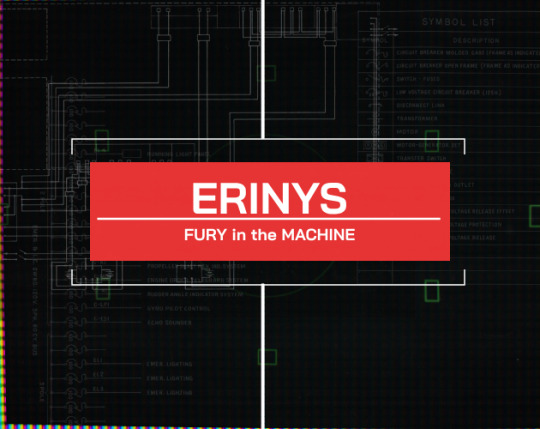
〔 DEMO (COMING SOON!) 〕 〔 CHARACTERS 〕〔 PLAYLIST 〕
Rated 18+ for violence and sexual content. Trigger warnings will be provided at the beginning of each chapter.
Twenty-seven years ago, the Giants woke up. Behemoth machines powered by AI machine learning, they destroyed much of the infrastructure of the world in a period known as The Fall. Humanity retreated to walled Cities -- first Kowloon, then others. And then Rider happened. A shining star in a half-formed mech, Rider beat back the Giants and became humanity's first and greatest hope. Then they died. And now there's you -- a carbon copy ten years later, built from a smattering of cells to kill the Giants and set the Cities free, an exact replica of the Rider the world knew and loved. You are one link in a chain of fallen soldiers. Cannon fodder, in smooth, pretty, porcelain white mechs. The white knights of the globe. They named you Fury. You're about to prove them right.
〔 FEATURES 〕
Customizable MC. Play as male, female, or non-binary; trans or cisgender; customizable pronouns.* Customize your appearance.
An angry clone. The anger keeps you alive, sure -- but what about the rest of you? Is your anger calm or explosive? Do you prefer to solve problems with violence or words? Do you meet problems head on, or work around them?
Who was Rider to you? Someone to look up to? A rival? A messiah?
Romance!! Or not!!!! Two romance options. Play as gay, straight, bisexual, or asexual; aro or alloromantic.
Get in the robot, Fury. Pilot your mech, DANIEL, and fight giant robots on the post-apocalyptic Great Plains. Exploit their weaknesses as rogue AI -- or just beat them into paste.
〔 ROMANCE OPTIONS 〕
Lane Black Kettle. [They/them] An Off-Gridder raised in surprisingly pleasant post-apocalyptia, Lane is in City 17 possibly illegally -- and definitely has a warrant out for their arrest. They can show you the nitty gritty underbelly of City 17, and a unique perspective on life outside the Walls. You just have to let each other in. Flavor of romance: The Outsider, enemies to lovers, snark as a love language.
Matthew "Mattie" Sorenson. [He/him] A computer genius whose obsession with the Giants tends to put people off, bug his overwhelming charisma and jovial nature reel them in again. Mattie wants to fix humanity's mistakes -- and you will help him. Flavor of romance: The Insider, competing egos, saving the world (and each other)
〔 OTHER DRAMATIS PERSONAE 〕
Luka Marik. [He/him] Your creator, the Alpha and Omega -- and a sad little man. Originally the creator of the mechs used to fight the Giants, Rider's death has left him with one purpose -- to bring them back to life.
Rider. [He/him or she/her] Begone, foul spirit, and let me not mourn you! Your genetic template, messianic savior of humanity, tragically killed in action ten years ago. Haunter of your narrative, very much against your will.
*Although many characters assume Fury is cis, the player will have several opportunities as the story progresses to transition -- including changing Fury's pronouns and aspects of their gender expression. Fury's transition will be a major plot point, if the player so chooses.
〔 TAGS + LINKS 〕
[FITM ASKS] [LANE] | [MATTIE] | [MARIK] [DISCORD]
296 notes
·
View notes
Text
It's hard to be nostalgic about Tumblr without remembering my friend Tru.
Truett McGowan.
What a fantastic name.
We met each other because we were both tech geeks following Leo Laporte. He was the very first live streamer. Originally he hosted a TechTV cable show called The Screen Savers. But once G4 took over and focused more on video games, Leo's show was cancelled and he was looking for a new way to broadcast content.
So he built a studio near his home and created his own infrastructure in order to live stream video on the internet. He called his new show "This Week in Tech" or TWiT for short.

Along with his new streaming venture he created a TWiT community using an open source microblogging platform called Laconica. It was a form of Twitter that you could create specifically for a single community. Basically a custom niche Twitter feed. I was trying to be a web designer back then, so I created custom themes for Lacnonica.
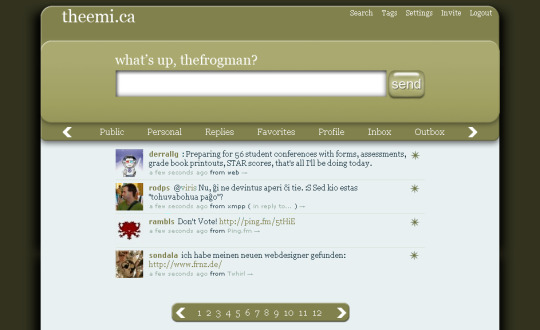
This was my own personal theme for a website that I ended up never launching.

Leo called his custom Twitter, "The TWiT Army." And I was his graphic designer and webmaster. I made all of the cute little graphics for the website.

I also did fun holiday themes...
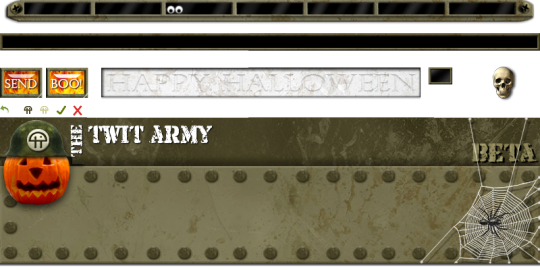
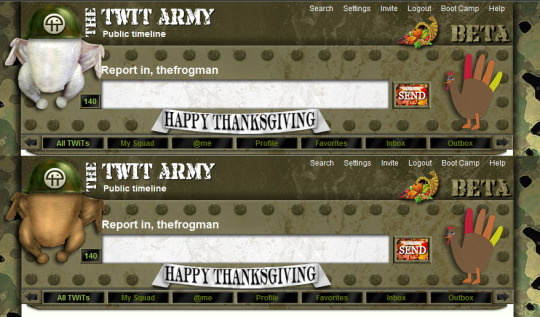
For the Thanksgiving theme, if you hovered over the Turkey it would change to being cooked.
I also took it upon myself to photoshop a little army helmet on the avatar of every single user of the site.

This was the zombie avatar I made for myself during Halloween.

The TWiT Army was also where I started posting my first attempts at Photoshop comedy. Many of them related to The TWiT Army.
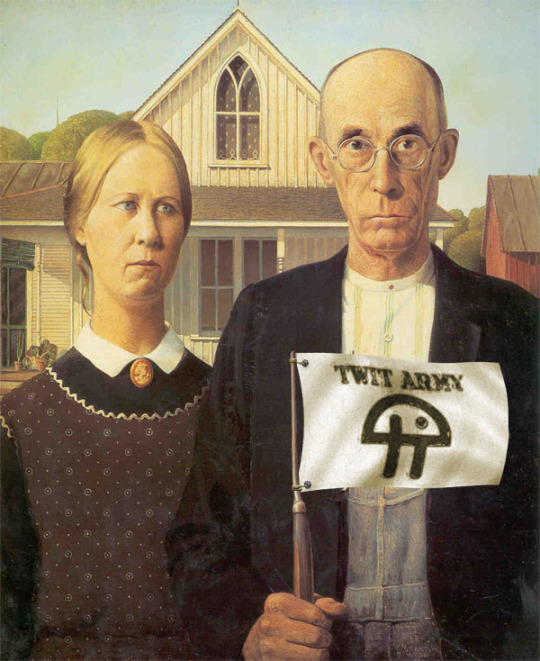



And The TWiT Army is where I met Tru. He used a space invader avatar. I made him a couple of different versions.

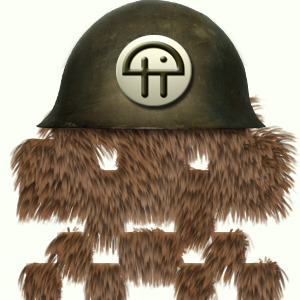
You may have seen his avatar on the sidebar of my main Tumblr.
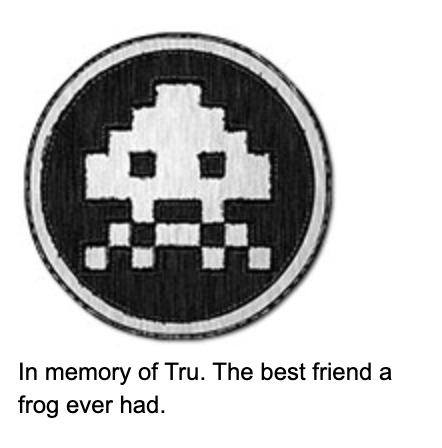
We became fast friends. We finished each other's jokes. We talked pretty much all day, every day. He loved Apple back then. I was strictly PC at the time. So we debated about that quite a bit. He would probably be astonished I have a MacBook and that I really love it too.
Our friendship lived in a little text box. We never talked outside of instant messages. But it was one of the most profound friendships of my life. I loved Tru just as much as any friend I've ever known in real life.
Tru started blogging on this brand new site called Tumblr. He reviewed apps for the iPod Touch. Not the iPhone, as that wasn't yet a thing.
I made the banner for his Tumblr.

He kept trying to get me to join Tumblr, but I was busy trying to create my own custom comedy website. But my site kept getting more and more complicated and I could never quite finish it. I was trying to arrange guest authors and create 3 months of content and I was always futzing with the theme and never happy with it.
I was getting frustrated that I could never launch my perfect comedy website and Tru suggested just making a Tumblr and posting funny stuff so I could be creative and have an outlet until my big site was ready to launch.
Little did I know Tumblr would end up being my big comedy website. Eventually I abandoned months of work and just stayed on Tumblr. All of my success here is pretty much because that little space invader pestered me to join when I was being stubborn.
Unfortunately, as some may have figured out already, the story gets sad from there. Tru mentioned briefly that he had a heart defect, but he never said it was serious. He acted like it was no big deal so I never thought too much about it.
We always talked through instant message and email, so we never exchanged phone numbers or addresses or anything like that. Tru was a very private person so he never even published an image of his face online. I only knew him as a space invader.
One day I woke up and sent him a message and got no reply. He usually woke up before me and answered as soon as I said hello. This had been our routine for nearly a year.
An hour went by. Two hours. Three hours.
It was odd for him not to respond for that long. I was really worried but all of my TWiT friends told me I was being paranoid. But there was a huge knot in my stomach telling me otherwise.
But then those hours turned into days. Days into weeks. Weeks into months. My worry grew exponentially as more time passed. I didn't know what to do. I tried finding his family. I even looked into hiring a private investigator. I don't know if I have ever felt a combination of depression & anxiety that intense.
In my heart, I knew what had happened. I knew that heart defect took his life. He was only 26 and it just didn't seem fair. But the not knowing for certain ravaged my mental health. Before all of this I had lost nearly 90 pounds and I gained it all back.
I think maybe a year or so later I found a friend of his who knew him in real life. They were finally able to confirm my suspicions. He passed away from his heart condition. That was my first real experience with grief. But I was so thankful for that bit of closure. I was finally able to let go of my anxiety and mourn him properly.
But Tru gave me such a wonderful gift. He pushed me to just start making things. To stop stalling and just create things to make people smile.
And you all probably know the rest from there.
121 notes
·
View notes
Text
rubbing my forehead to cope with reading an article where the author claims Zaibach is like the USSR. unnngggghhhhhh only if the USSR resembled ridley scott's 1984 apple ad, lol.
well, aside from the deutschy name and being inspired by industrial revolution era england— a colonial power— headed by a protestant english symbol of western thought creating the world as he wants/understands it straight from the 1700s to 1996, i see the show as using his belief that god must necessarily have a hand in driving the natural world (Newton insisted that divine intervention would eventually be required to reform the [planetary] system, due to the slow growth of instabilities) extrapolated to him eventually viewing himself as such a god. but forgetting all of that,
Zaibach

i think the name is mostly nonsense, but fwiw the hebrew verb "zabach" primarily means to sacrifice or to slaughter, particularly in the context of offering an animal to God as an act of worship.
Metropolis (1927) concept art by erich kettelhut

Zaibach

Metropolis was made during the era of the weimar republic (the german reich.) things were really shit because of WWI, then oh! prosperity! while the resentment and hatred from the right boiled, then the great depression ended that prosperity, then the nazis came into official power. Metropolis is known for having been greatly edited (endlessly recut and with versions lost) such attempts in part were to remove the communist-sympathising subtext in a film about a false and fairly explicitly german utopia— inspired too by the tower of babel and 1920s new york skyline— for the wealthy elite... wherein those same elite plot and scheme to construct clever events to keep themselves in power and remove the need for workers at all by destroying them and relying instead on machines (see: the great worker riot of 2026.) don't get me wrong though— there's plenty to criticise about Metropolis, much of it coming from Lang himself.
there are 3 major, interconnected machines which run the city. this one is called The Heart Machine.

the "Heart Machine", which is the central dynamo that generates most of the power to the entire city. Every day it produces an average of 1000 megawatts of power that is transferred through various power nodes throughout the machine room complex. The machine has run non-stop for 25 years with the exception of pausing for preventive maintenance. Unlike most equipment build in the late 1900s to the 2020s, these machines were built not to be replaced. The heart of the city system was built by Fellar, Inc. and came with a price tag of 78.7 million M.
The Heart Machine is under the charge of one man, Grot, a worker who has maneuvered his way up through the ranks by "helping" uncover covert information about the workers.
(from here)
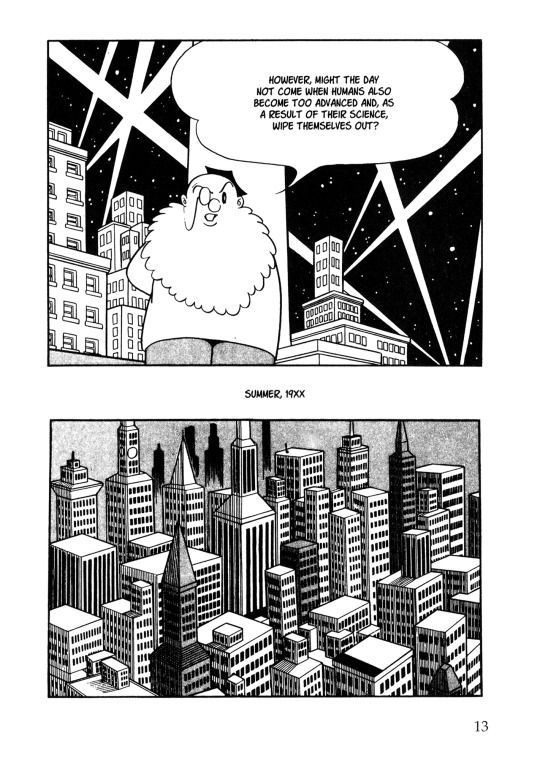
Metropolis, osamu tezuka
also, if you're interested in the approach to design—
The film's use of art deco architecture was highly influential, and has been reported to have contributed to the style's subsequent popularity in Europe and America.
art deco had no goal or philosophy of restructuring society/lifestyle. it glamourised the industrial revolution, moreover the opulence that everyone but the workers enjoyed, seeking to symbolise wealth and sophistication and rejection of tradition. Art Deco design exemplified opulent consumption, crass commercialism, and the acceleration of contemporary life summed up in the Futurist credo "Speed is beauty." (here. also would like to add that most? all? in the futurist movement were italian fascists who went and died in the war, effectively killing the futurist movement too.) however, in america, whose infrastructure was impacted far less by the war than europe, the style continued almost seamlessly into the new international movement— such is the case with any decade and its trappings; there's no actual definitive beginning or end to an era, especially for poorer people (whose customs and ideas are upcycled by the wealthy.) all of this art was continued or discontinued more randomly than that. ftr though i'm using generalities as opposed to finer details here only for the purpose of discussing what/how things appear in Escaflowne.
the exterior of Zaibach is more art deco while the interior, as well as that of Escaflowne itself, are from the movement of the pre-WWI art nouveau— since they're both related to Atlantis/draconians, who within the series have the strongest association with art nouveau as if a symbol of their elegant idealism, that makes sense. art nouveau sought to establish a "synthesis of the arts" (Gesamtkunstwerk) breaking down the previously firm distinction between fine art and applied art— incorporating the lushness and assymetry of nature into architecture, stained glass, metalwork, etc. etc., allowing rooms and practical/functional objects to "become" art as well, with the same approach as illustrations. it also should be said that art nouveau pulled heavily from japanese prints, as seen previously in the orientalist """japonisme.'"""




hôtel tassel, the peacock room, myst III exile
Decorative artists experienced a rise in status following the turn of the century; similarly, a rise in wealth and social as well as technological progress gave birth to the widespread luxury industry. This golden combination solidified the Art Deco movement.
William Morris, the founder of the art nouveau arts & crafts movement in england, was a staunch revolutionary socialist/anti-imperialist. he believed one should "have nothing in your houses that you do not know to be useful or believe to be beautiful." according to him, the main goals of the movement were "to give people pleasure in the things they must perforce use, that is one great office of decoration; to give people pleasure in the things they must perforce make, that is the other use of it." during a time which saw the beginnings of mass-production, the intended effect of this was to restructure a person's relationship to even the mundane items in their possession (see: commodity fetishism) and in that process, exposure to and relationship to art.
art deco suffered heavily during the aforementioned great depression because the materials to make it were no longer affordable and the labour classes exploited for other means. so i view it as... dornkirk claims he did all the shit himself but we know he's building on these ancient ideas and amassing/hoarding resources to achieve this, and he's keeping these organic forms— as representative of the natural world and part of that world being humanity— for himself exclusively as he burns the world down. however, we're not moralising art here, just as fritz lang regretted focusing on the moral over the social. escaflowne is also a weapon of war and must be put to rest as part of van's own break from punitive tradition.

ultimately, what we see in Escaflowne is people— while retaining any surface-level, or even essential and difficult differences, made even more clear by the sheer amount of different cultures/customs to which we're exposed— changing the calamitous course of fate when committed to a common goal, quintessentially represented by communal, mutual love and respect. i would say that's much more communist than what Zaibach represents.
#escaflowne#i think it's sort of fucked to assume any japanese artist— but esp the people who made gundam— don't consider this stuff.#like art/history/art history is the purview of the west exclusively and not applicable to fantasy anime somehow#maybe it's not that deep but it's certainly not unthought or vapid
15 notes
·
View notes
Text
Cost vs. Quality: What to Consider When Investing in Switchgear

In today’s energy-intensive world, switchgear plays a critical role in managing power distribution safely and efficiently. Whether you’re upgrading your industrial facility, building a commercial plant, or powering a large infrastructure project, choosing the right switchgear is not just a technical decision — it’s a strategic investment. One of the most common dilemmas buyers face is balancing cost vs. quality. So, how do you decide?
Understanding Switchgear: The Heart of Electrical Safety
Switchgear is a combination of electrical disconnect switches, fuses, or circuit breakers used to control, protect, and isolate electrical equipment. Its primary role is to ensure the reliability and safety of your power system.
Types of switchgear include:
· Low-voltage switchgear (for commercial and residential use)
· Medium-voltage switchgear (typically for industrial applications)
· High-voltage switchgear (used in power transmission)
Investing in the right switchgear directly impacts operational continuity, personnel safety, and overall infrastructure reliability.
The True Cost of Cheap Switchgear:
While it’s tempting to opt for budget-friendly solutions, low-cost switchgear often comes with hidden risks and long-term expenses.
Inferior Material Quality
Cheaper models often use substandard materials that degrade faster, leading to frequent maintenance or early replacement.
Safety Hazards
Low-quality switchgear can result in arc faults, insulation failure, or overheating — putting workers and equipment at risk.
Increased Lifecycle Costs
Although the initial price may be low, the total cost of ownership (including downtime, repair, and energy inefficiency) is usually higher.
Limited Scalability and Customization
Budget systems are often rigid and harder to scale as your facility grows or needs change.
Why Quality Switchgear Pays Off
When you invest in premium switchgear, you’re not just buying a product — you’re buying peace of mind.
Enhanced Reliability
High-quality switchgear is engineered to perform in extreme conditions and handle high fault levels without compromising performance.
Superior Safety Standards
Reputable brands comply with international standards such as IEC, ANSI, or UL, reducing liability and improving workplace safety.
Ease of Maintenance
Well-built switchgear is modular and user-friendly, simplifying diagnostics and minimizing downtime during maintenance.
Energy Efficiency & Smart Capabilities
Modern switchgear includes IoT sensors, real-time monitoring, and predictive maintenance features, ensuring optimal energy use and proactive problem resolution.
Key Factors to Consider When Choosing Switchgear
When evaluating switchgear options, balance cost and quality by focusing on the following:
1. Application Requirements
Understand your voltage class, load types, and fault current ratings. Quality should match your operational demands.
2. Brand Reputation & Certification
Look for trusted brands with certifications like ISO 9001, CE, or IEC 62271. Positive reviews and case studies add credibility.
3. Lifecycle Costs
Don’t just compare sticker prices — consider maintenance, service availability, spare part costs, and expected lifespan.
4. Customization & Flexibility
Choose systems that can evolve with your operation. Modular designs support upgrades and expansions more efficiently.
5. Support and Service
Ensure the manufacturer provides robust after-sales support, technical training, and warranty services.
Cost vs. Quality: The Bottom Line
When it comes to switchgear, cheap is rarely cheerful. Cutting corners today can lead to outages, hazards, and hefty repair bills tomorrow. On the other hand, investing in high-quality switchgear ensures operational resilience, safety, and long-term savings.
The smartest strategy? Aim for value, not just price. Evaluate switchgear as a long-term asset, not just a one-time purchase.
Trending Tip: Think Smart and Sustainable
With rising energy demands and climate-conscious regulations, smart and sustainable switchgear is trending. Look for:
· Eco-friendly insulation (like SF₆-free switchgear)
· Energy management features
· Digital monitoring systems
Investing in such features not only future-proofs your infrastructure but can also help you qualify for green certifications and incentives.
Final Thoughts
Balancing cost and quality in switchgear selection is about understanding your long-term operational goals. By focusing on durability, safety, and lifecycle value, you can make a decision that protects both your budget and your business.
8 notes
·
View notes
Note
I would love to hear why East Richmond exists
Firstly: apologies it took me a couple of days to reply to this ask. I needed the time to untangle my complicated feelings toward East Richmond's existence.
One of the primary justifications that can be made for East Richmond's existence is simple: the early bird gets the worm. East Richmond was built in 1860, preceding Burnley's opening by 20 years. The route 70 tram down Swan Street hadn't been created yet either, and wouldn't be for several more decades. The real question, of course, is why it continues to exist, especially given how much rail infrastructure has disappeared over the years. This is a little bit more speculative on my part.
In the 1960s, the track between East Richmond and Burnley was quadrupled with the creation of an express track in both the inbound and outbound directions. Both stations are provisioned with infrastructure which allows for trains to leave the express track and continue their journeys via the non-express track. This means the section of track between Richmond and Camberwell is one of the few places in the metropolitan train network where express trains are actually express (i.e., capable of overtaking each other during ordinary train operations). Theoretically, other lines have junctions where some of the same capability should exist (holding a stopping all stations service on one platform so the express train can run ahead of it) but as the same infrastructure hasn't been built, there is no effective way to build a timetable that makes better use of the functionality.
It is also worth noting that prevailing wisdom suggests that it is always preferred to hold a train at a platform as customers tend to get antsy about being stuck on a stationary train that they can't get off 🥲.
Long story short, East Richmond station (and more importantly, the points/turnouts that have been grandfathered in because of it) has allowed for better timetable capacity for trains travelling through to Camberwell and Glen Waverley. At this point it would probably cost more money to get rid of it than to let it be, so East Richmond lives on to fight another day! I am also lead to believe it has surprisingly good patronage numbers given its relative lack of actual services.
#the REAL reason I think East Richmond exists however is to be VEXATIOUS#it is FAR too easy for a signaller to accidentally run a train that is MEANT to stop at East Richmond down the express line instead#and there is only a few seconds to correct the mistake given#the close proximity of Richmond station#it is very frustrating to write an incident report for a station skip when it can be seen on the cctv that nobody was waiting there#and that nobody would be waiting there#because it's 1am#and it's East Richmond#but that's just what I've heard 🫢#asha answers#tess-is-elated#sidenote: was very happy to see your name in my inbox#and in general as well#i hope you've been doing well#just train things#just melbourne things#just australia things#always here to answer questions of this nature#and always probably in more detail than anyone could have dared anticipate (even myself) 🫡
11 notes
·
View notes
Text
Why Dr. Niranjan Hiranandani is Recognized as a Leader in Indian Real Estate?

Dr. Niranjan Hiranandani is a name synonymous with innovation and transformation in the Indian real estate industry. As one of the top real estate leaders in India, he has played a crucial role in shaping urban infrastructure and pioneering integrated township development. His forward-thinking approach to urban planning and his commitment to sustainability have set new benchmarks for modern cityscapes. His leadership has not only revolutionized the sector but has also influenced policies and set new standards for urban living.
With a deep understanding of market needs and future trends, Dr. Niranjan Hiranandani’s leadership has been instrumental in creating self-sustaining communities that blend luxury with functionality. His projects stand as testaments to sustainable architecture, smart infrastructure, and customer-centric development.
Revolutionizing Urban Living: The Hiranandani Legacy
Integrated Township Model
Dr Niranjan Hiranandani redefined urban development by introducing the integrated township concept in India. His vision led to the creation of landmark developments such as Hiranandani Gardens in Powai, Hiranandani Estate in Thane, and Hiranandani Fortune City in Panvel. These projects transformed underdeveloped areas into thriving residential and commercial hubs, offering a perfect blend of housing, business centers, recreational facilities, and retail spaces.
Sustainable and Green Development
Sustainability is at the core of urban planning by Niranjan Hiranandani. His developments focus on eco-conscious architecture, integrating features like rainwater harvesting, solar power, waste management systems, and tree-lined avenues. His projects prioritize green spaces and energy-efficient designs, promoting an environmentally responsible lifestyle for residents.
Creating New Geographies
A hallmark of Dr. Niranjan Hiranandani’s leadership is his ability to identify and develop emerging real estate corridors. He was one of the first to envision Panvel as a future residential and commercial hub, leading to the development of Hiranandani Fortune City. Similarly, he played a key role in transforming Oragadam in Chennai and Alibaug into high-potential growth destinations.
A Leader with a Customer-Centric Vision
Beyond Brick and Mortar
Unlike many developers who focus solely on construction, Dr. Niranjan Hiranandani emphasizes customer experience and lifestyle. He believes that real estate is not just about building structures but about creating communities where people thrive. His attention to detail, from architectural excellence to world-class amenities, ensures that each development offers a premium living experience.
Customer-First Approach
Understanding evolving homebuyer expectations has been a driving force behind Hiranandani Communities' success. Dr. Hiranandani prioritizes modern amenities, wellness-driven infrastructure, and convenience-oriented living, ensuring that each township offers everything from healthcare and education to retail and entertainment within close proximity.
Leadership and Innovation in Real Estate Development
Adopting Cutting-Edge Technology
As a business leader of the year, Dr. Niranjan Hiranandani has continuously embraced technological advancements in real estate. His projects incorporate PropTech solutions, smart city infrastructure, and digital innovation to enhance customer experiences and streamline urban planning.
Innovation in Construction
His pioneering approach has introduced precast technology, green building practices, and smart infrastructure to Indian real estate. By integrating sustainable materials and futuristic designs, his developments are built to withstand changing urban demands while ensuring minimal environmental impact.
Commitment to Sustainable Urban Development
Dr. Hiranandani’s commitment to sustainability-driven urban planning sets him apart from other Indian business leaders. His projects incorporate:
Energy-efficient homes with advanced insulation techniques.
Rainwater harvesting systems and sewage treatment plants to conserve water.
Eco-friendly landscapes with ample green spaces to reduce carbon footprints.
Through these initiatives, Hiranandani Communities has redefined real estate by promoting eco-conscious living without compromising on modern luxuries.
Industry Leadership and Influence
Policy Advocacy and Regulatory Contributions
Dr. Niranjan Hiranandani has played a pivotal role in shaping real estate regulations in India. As the former President of NAREDCO and an influential voice in CREDAI, he has been a strong advocate for transparency, ethical business practices, and industry reforms. His leadership has contributed to real estate policies that protect homebuyers while ensuring sustainable industry growth.
Thought Leadership
Recognized as one of the top Indian business leaders, Dr. Hiranandani frequently shares insights on real estate trends, infrastructure growth, and investment strategies. As a key speaker at industry summits, he educates stakeholders on the future of urban planning, sustainable development, and emerging real estate trends.
Expanding Beyond Real Estate: Healthcare & Education
Hiranandani Healthcare Initiatives
Beyond real estate, Dr. Niranjan Hiranandani has made significant contributions to healthcare. He is a trustee of Hiranandani Hospital, a renowned institution that has set benchmarks in transplants, critical care, and advanced medical treatments in Mumbai. His vision for healthcare emphasizes accessibility, affordability, and cutting-edge medical technology.
Education and Youth Empowerment
Dr. Hiranandani has also played a key role in education through initiatives like Hiranandani Foundation Schools. By investing in high-quality education, he is fostering the next generation of business leaders in India. His support for skill development programs and academic excellence highlights his commitment to holistic nation-building.
Niranjan Hiranandani: The Architect of Modern Urban India
Dr. Niranjan Hiranandani’s legacy extends far beyond real estate. As an industry pioneer, innovator, and philanthropist, his contributions have reshaped the landscape of urban India. By blending sustainability, technology, and customer-centric development, he continues to set new benchmarks in real estate.
His influence reaches beyond buildings and into communities, driving positive socio-economic change and setting an example for future entrepreneurs. With an unwavering commitment to excellence, he remains one of the most respected business leaders in India.
Conclusion: A Legacy That Inspires Future Entrepreneurs
Dr. Niranjan Hiranandani’s impact on Indian real estate is undeniable. His ability to predict market trends, implement sustainable solutions, and prioritize customer satisfaction has cemented his status as a visionary leader. His customer-first approach and innovative urban planning continue to inspire real estate professionals, investors, and policymakers.
His contributions will shape the future of urban living for decades to come, proving that true leadership is about more than just business—it’s about creating a better tomorrow.
FAQs
1. What makes Dr. Niranjan Hiranandani a leader in Indian real estate?
His pioneering work in integrated township development, sustainable urban planning, and customer-centric real estate solutions sets him apart from other top real estate leaders in India.
2. How has Hiranandani Communities transformed urban living in India?
By developing self-sustaining townships that integrate residential, commercial, retail, and green spaces, Hiranandani Communities has redefined urban living.
3. What are some of Dr. Niranjan Hiranandani’s most notable real estate projects?
Hiranandani Gardens (Powai), Hiranandani Estate (Thane), and Hiranandani Fortune City (Panvel) are among his most transformative projects.
4. How does sustainability play a role in Hiranandani real estate developments?
His projects incorporate energy-efficient designs, green building practices, water conservation systems, and extensive landscaping to promote sustainable living.
5. What is Dr. Niranjan Hiranandani’s vision for the future of Indian real estate?
He envisions smart, sustainable, and future-ready cities that cater to evolving urban lifestyles while preserving environmental balance.
10 notes
·
View notes